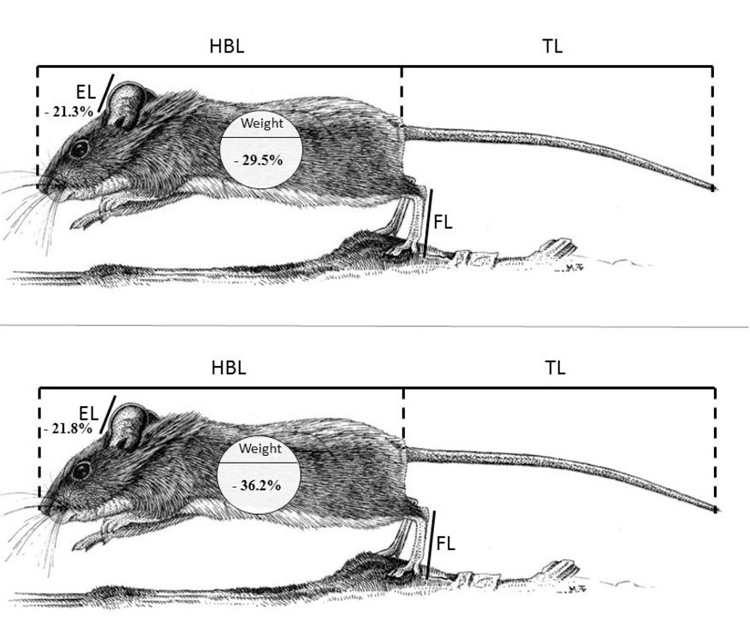Thermoregulation, metabolism and life history of species are affected by body size and shape. Based on specimens of the wood mouse Apodemus sylvaticus that were collected at Doñana National Park in 1978–81 and 2006–07, changes in body mass, body size, and allometry were tested between these periods. Furthermore, data from 1978–81, when more specimens were available, were used to evaluate the sexual dimorphism of adults. Between the two periods and regardless of age, the most striking reduction in size in both females and males concerned body mass (females ?29.5%, males ?36%) and ear length (?20% for both sexes). Although less pronounced (3–4%), also a significant reduction in the total cranial and the condyle-basal lengths of females but not of males was observed. No change was evident for the zygomatic width and the diastema length and for the head-body and hind foot lengths in either sex. The allometric relationships between the measured traits and the head-body length in adults did not change between the two periods. Males were larger than females in all the measured traits except the zygomatic width and the ear length. No sexual dimorphism was evident relative to the static allometry of adults. A major determinant of this reduction may have been a shortage in suitable resources. Overall, this study confirms and extends previous findings on male-biased sexual size dimorphism and reveals a dramatic decline in body mass, which is likely linked to the observed reduction in species abundance at Doñana. The extent and rapidity of the observed morphological changes raise concerns about the conservation of Doñana ecosystems and pose questions for future research on the ecological processes that caused these changes. informacion[at]ebd.csic.es: Docampo et al (2019) Marked reduction in body size of a wood mouse population in less than 30 years. Mammalian Biol https://doi.org/10.1016/j.mambio.2018.09.010
https://www.sciencedirect.com/science/article/pii/S1616504718300703?via%3Dihub  Latest News
Latest News
 Las altas temperaturas están provocando que las lagunas y las marismas de Doñana pierdan agua rápidamente
Las altas temperaturas están provocando que las lagunas y las marismas de Doñana pierdan agua rápidamente
La superficie inundada en la marisma es de un 78% pero la profundidad es escasa. Por otra parte, sólo el 1,9% de las lagunas temporales están inundadas. Las precipitaciones crean una oportunidad...
 Traffic noise causes lifelong harm to baby birds
Traffic noise causes lifelong harm to baby birds
A study with CSIC participation reveals for the first time that car noise harms individuals throughout their lifetime even years after exposure
 Illegal wildlife trade, a serious problem for biodiversity and human health
Illegal wildlife trade, a serious problem for biodiversity and human health
A research team led by the Doñana BIological Station and the University Pablo de Olavide have detected wild-caught pets in 95% of the localities in the Neotropic and warns of the risk of zoonotic...
 Urbanization and loss of woody vegetation are changing key traits of arthropod communities
Urbanization and loss of woody vegetation are changing key traits of arthropod communities
Urbanization is favouring smaller beetle species and larger spider species with greater dispersal capacity.
The loss of woody areas is linked to a decline in the duration of the activity...
The loss of woody areas is linked to a decline in the duration of the activity...
 Blood lead levels in an endangered vulture species decreased following restrictions on hunting practices
Blood lead levels in an endangered vulture species decreased following restrictions on hunting practices
Canarian Egyptian vulture was on the verge of extinction at the end of the 20th century. At that time, studies revealed that lead poisoning was a serious problem for the population’s survival. The...
— 5 Items per Page
 Asset Publisher
Asset Publisher
Back






